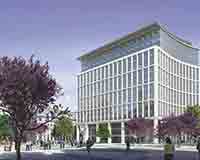Size, it seems, is important in Manchester’s office market. Occupier requirements are up and when those convert to deals they appear to be for larger units (see below).
“A number of occupiers got their fingers burnt in the recession by trying to get the amount of space spot-on – and then found themselves in trouble when the economy improved, as they were growing by up to 10% but locked into offices with no swing space,” says Will Lewis, founding director of OBI Property. “As a result, many are now being bullish in their growth aspirations.”
Although much agent talk is devoted to footloose requirements that have already touched down in Manchester (no need to recount them again here) and there is much excited speculation, hard and fast names are thin on the ground. That doesn’t bother JLL director Chris Mulcahy. “Just because there aren’t 10 on the horizon doesn’t make it disaster-ville,” he says.
What the market should be concerning itself with, he suggests, is providing the next generation of accommodation for them. “Because of the speed at which inward investors need space, we need to ensure we maintain a decent amount of supply,” he says.
Lambert Smith Hampton’s Josh Levy says: “The debate is whether there is enough for now and no new development [outside the current construction pipeline] is needed to complete until 2019-20.” He suggests that any developer looking to develop a new-build office needs to start now, otherwise they will find themselves waiting in the queue with a host of competing projects.
In the case of the five large-scale schemes currently under construction across the city (totalling around 1m sq ft), some developers are already on the case (see box overleaf), though OBI’s Lewis suggests that more thought needs to go into the wider realm in which the workspace is conceived.
“They need to do more than just offer big standalone office blocks. Businesses want buildings with cafés, restaurants, roof-top terraces, gyms, touch down space – London is doing this, and buildings in Manchester that provide amenity and become a real place will end up being the most successful.”
Not all of the schemes currently coming out of the ground will be competing for the same tenants, however. “Several are positioned to appeal to occupiers looking for Grade A space at a discount to the higher rents of the prime developments which are now £34 to £35 per sq ft,” says Cushman & Wakefield director Rob Yates.
That rental gap could widen to 15%, predict market observers, and a limited amount of refurbished space is waiting in the wings, too, with developers also considering how to attract smaller businesses (see box, below).
Outside central Manchester, increasing activity is forecast in Salford Quays, notably at Hunter REIM’s Exchange Quay, where the remaining 180,000 sq ft of refurbished space is likely to diminish quickly over the coming year.
“We will see average rents increase on grade-A space (excluding MediaCityUK) towards and possibly above the £20 per sq ft threshold which will still show a 33% discount on prime city centre rents only 1.5 miles down the road,” says Mark Canning, director of Canning O’Neill.
The joy of co-working
 The co-working and flexible space revolution has arrived in Manchester with a vengeance. There are currently eight providers touting for the attention of Macbook-toting creatives, with a further three in the pipeline.
The co-working and flexible space revolution has arrived in Manchester with a vengeance. There are currently eight providers touting for the attention of Macbook-toting creatives, with a further three in the pipeline.
The phenomenon is as fresh as a digital marketeer’s notebook. “There was no co-working space in Manchester when we started two years ago,”
recalls Alex Hill, head of business and operations of Hello Work, the consumer-facing standalone brand of Allied London.
There have been hiccups for the sector along the way: TechHub closed down, to be reincarnated as SpaceportX, but for now co-working space in Manchester is bang on trend. “We’ve seen a lot of interest from occupiers in London,” says Hill, who suggests that the combination of low occupation costs, a high student population and a concentration of research facilities, including the new Graphene Institute, are a winning combo.
Hello Work plans to operate three centres in the city – at Old Granada Studios, the XYZ Building and in the Northern Quarter – totalling 20,000 sq ft.
Questions about the sustainability of co-working space have already been addressed by Hello Work, according to Hill. “We’re curating a village concept where live/work space forms part of a larger cluster,” he says.
Developer view
One of the less-publicised facts about the recent raft of inward investment occupier deals signed in Manchester is that tenants have sought highly efficient floorplates that offer densities as high as 1:6, although for the foreseeable future actual levels of occupation will be closer to the norm of 1:10. Another subtle shift in the market, observes ASK Developments’ managing director John Hughes, is the rising popularity of city centre offices.
He says: “In businesses that have traditionally located on business parks, it is apparent that the younger influencers and decision makers are recognising that to attract and retain the best talent they need to be in modern buildings located within short walking distance to multi-modal transport hubs alongside high-quality and relevant retail and leisure amenities.”
This increased demand for centrally located demand won’t necessarily result in a rash of new developments, reckons Phil Mayall, development director at Muse Developments. He says: “Funding for wholly speculative development has not yet returned to the market, although the amount of prelet space necessary to secure funding is falling.”
Like Mayall, other developers appear confident that the chances of landing prelets are significantly higher than they were just a year ago. Those with schemes that have ownership, planning and obstacles like rights to light removed will be best placed to capitalise.
Size requirements: Things are getting bigger
In most UK office markets small suites form the bread-and-butter backdrop of the market, but this year Colliers International believes there has been a shift in Manchester. In the first half of 2015 there were 25 deals involving city centre Grade A office space of more than 5,000 sq ft, accounting for well over 60% of all space let in the city centre.
Five years ago there were about the same number of deals but suites of more than 5,000 sq ft accounted for less than 50% of the market, says Colliers’ director Peter Gallagher. This trend is expected to continue for the rest of this year as a number of large occupier requirements are still circling the city (see main text).
Gallagher notes that historically 85% of enquiries for offices are for suites of less than 5,000 sq ft. “That percentage has begun to fall – whether that’s an emerging trend is too early to call,” he says. Several factors appear to be at work including economic growth and an increase in newcomers to Manchester.
Those taking large amounts of space in future, according to Colliers, include financial services, professional and digital services occupiers.















